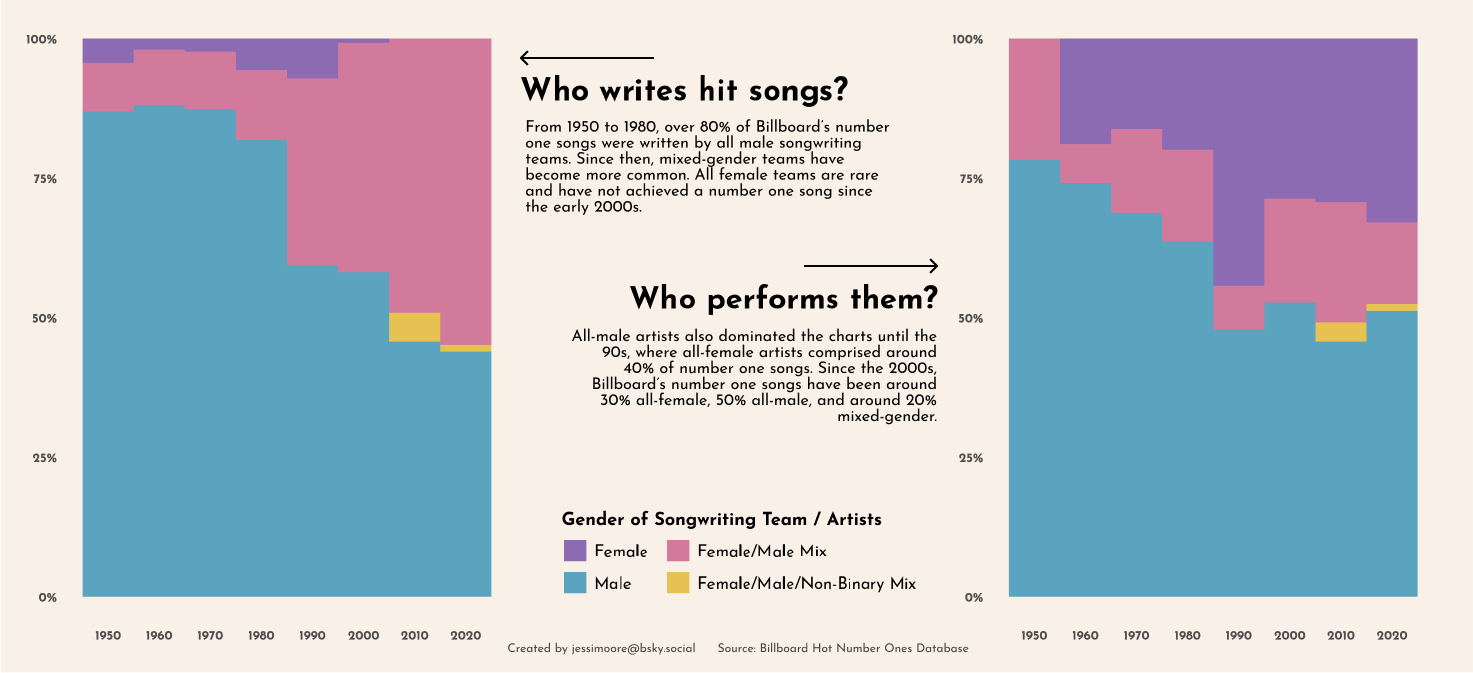Load data and libraries
library(tidyverse)
library(patchwork)
library(paletteer)
library(ggstream)
library(sysfonts)
library(showtext)
tuesdata <- tidytuesdayR::tt_load('2025-08-26')
billboard <- tuesdata$billboard %>%
drop_na(songwriter_male)August 31, 2025
This week’s TT dataset came from Billboard Hot 100 Number Ones Database. With such a rich dataset and so many variables it was difficult to know where to even begin. I tried out a few options before settling on exploring gender of songwriters and artists over time.
I edited the final combined plot using Figma, which made customising the text much easier.

b <- billboard %>%
mutate(year = 10 * (year(as.Date(date)) %/% 10),
songwriter_male = factor(case_when(
songwriter_male == 0 ~ "Female",
songwriter_male == 1 ~ "Male",
songwriter_male == 2 ~ "Female/Male Mix",
songwriter_male ==3 ~ "Female/Male/Non-Binary Mix"))) %>%
# removing 2025 as there is only one song in dataset
filter(year != 2025) %>%
count(year, songwriter_male)p <- ggplot(b,
aes(year, n, fill = songwriter_male))+
geom_col(position = "fill", width = 10) +
scale_y_continuous(labels = scales::percent) +
scale_fill_manual(values = pal) +
scale_x_continuous(
breaks = seq(1950,2020,
by = 10)) +
labs(x = NULL, y = NULL, fill = "Gender of Songwriting Team") +
theme_minimal() +
theme(axis.text = element_text(family = ft, size = 12, face = "bold"),
legend.title = element_text(family = ft, size = 12, face = "bold"),
legend.text = element_text(family = ft, size = 12)) +
themeb2 <- billboard %>%
mutate(year = 10 * (year(as.Date(date)) %/% 10),
artist_male = factor(case_when(
artist_male == 0 ~ "Female",
artist_male == 1 ~ "Male",
artist_male == 2 ~ "Female/Male Mix",
artist_male ==3 ~ "Female/Male/Non-Binary Mix"))) %>%
# removing 2025 as there is only one song in dataset
filter(year != 2025) %>%
count(year, artist_male)p2 <- ggplot(b2,
aes(year, n, fill = artist_male))+
geom_col(position = "fill", width = 10) +
scale_y_continuous(labels = scales::percent) +
scale_x_continuous(
breaks = seq(1950, 2020,
by = 10)) +
scale_fill_manual(values = pal) +
labs(x = NULL, y = NULL, fill = "Gender of Songwriting Team") +
theme_minimal() +
theme(axis.text = element_text(family = ft, size = 12, face = "bold"),
legend.title = element_text(family = ft, size = 12, face = "bold"),
legend.text = element_text(family = ft, size = 12)) +
theme# Create the titles
t1 <-
ggplot() +
theme_void() +
geom_text(aes(x = 0, y = 0), label = "Who writes hit songs?", family = ft, size = 8, lineheight = .5, fontface = 'bold') +
theme(axis.text = element_blank())
t2 <-
ggplot() +
theme_void() +
geom_text(aes(x = 0, y = 0), label = "Who performs them?", family = ft, size = 8, lineheight = .5, fontface = 'bold') +
theme(axis.text = element_blank())
# Design patchwork layout
layout <- c(
area(1,1,3,1), #p1
area(1,2,1,2), #t1
area(2,2,2,2), #legend
area(3,2,3,2), #t2
area(1,3,3,3) #p2
)
combined_plot <- p + t1 + guide_area() + t2 + p2 +
plot_layout(design = layout, guides = "collect") &
theme